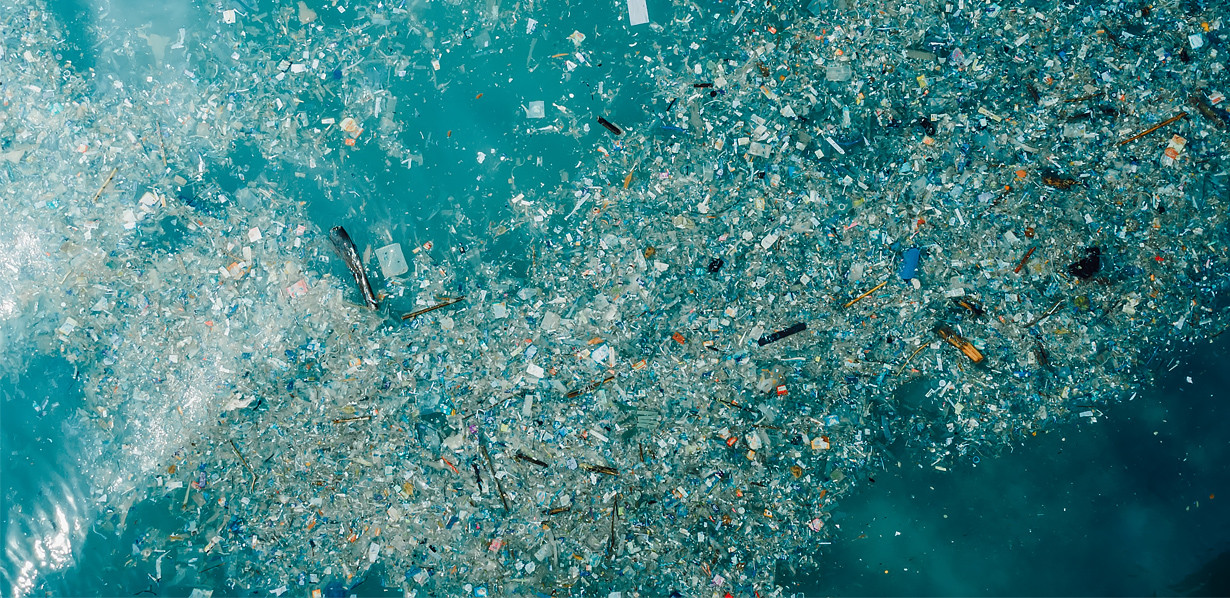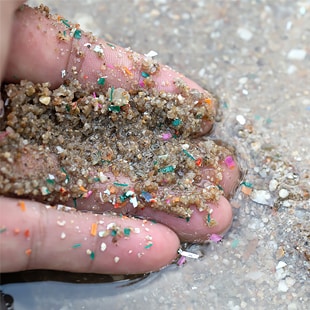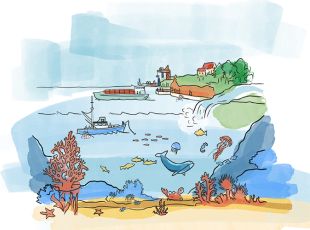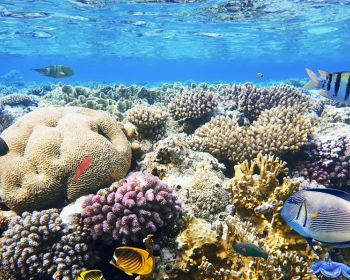Marine pollution is at a critical point
For decades, the Ocean has been facing widespread contamination due to two types of pollution: plastic pollution, which is the most visible, and chemical pollution.
An Ocean overflowing with plastic waste...
Every year, fifteen million tons of plastic is dumped into the Ocean. From 2000 to 2019, the global volume of plastic waste more than doubled from 234 to 460 million tons as plastic production increased at a similar rate. With certain scenarios projecting that the production of plastics is expected to triple by 2060, the situation is likely to worsen in the absence of global regulation. Furthermore, current waste management structures are insufficient: the OECD (Organisation for Economic Co-operation and Development) estimates that 90% of plastics are not recycled globally. Of these, 20% are burned (which generates particle pollution that is emitted into air) or released into the environment. These pollutants make their way into pipelines and contaminate waterways before they eventually end up in the Ocean.
of plastics are not recycled globally.
"Limiting the leakage of plastic or chemical substances into marine environments requires better upstream waste and wastewater management."
For Victoria Leccia, it’s clear that an upstream approach is needed: "Limiting the leakage of plastic or chemical substances into marine environments requires better upstream waste and wastewater management." Wastewater management leads to the gradual fragmentation of plastic debris called microplastics: 95% of the plastics present in the Ocean measure less than 5 millimetres.
Currently, it is estimated that there are at least 24 trillion microplastic waste particles, or "plastic pellets", in the upper layers of the Ocean alone. Invisible to the naked eye, theses microplastics are everywhere in our ecosystems, often ingested by fish as they infiltrate food chains. In fact, many scientists are now warning about the presence of microplastics in the food we eat.
… and endangered by chemical pollution
Chemical pollution poses significant risks to our health, the environment and the economy. In fact, the "Toxicity: The Invisible Tsunami" study from Deep Science Ventures (2025) considered chemical pollution to be a threat comparable to climate change for nature and living organisms. As with plastic pollution, chemical pollution comes from industrial activities that are not directly linked to the blue economy. These industrial activities must be regulated to address their environmental impact, particularly in regard to biodiversity.
For instance, fertilizer and pesticide runoff can lead to chemical pollution in waterways before ending up in the Ocean. Some studies show that significant levels of heavy metals and persistent organic compounds such as PFAS – perfluoroalkyl substances often referred to as “forever chemicals” – can be detected in fish. Studies are also examining how these chemicals may effect fertility and endocrine functions or cause other illnesses in humans. Thus, it is critical to support best practices to preserve the health of both ecosystems and our own well-being.
Awaiting regulation at the global level
At the United Nations Ocean Conference (UNOC) in June 2025, of which BNP Paribas was an official sponsor, 95 countries advocated for an ambitious and robust international plastic pollution treaty. This treaty would consider the entire lifecycle of plastics and set a global target to reduce the production and consumption of virgin plastic. The negotiations that took place in Geneva from 5 to 15 August 2025, following those in Busan at the end of 2024, have not been successful. Consequently, several states in favour of an ambitious treaty – including the European Union, Colombia, Australia and the United Kingdom – may seek to establish a "multilateral treaty between voluntary states".
Tackling pollution at the source: preventing and controlling marine pollution
Financial institutions have a key role to play in tackling marine pollution by supporting companies in their transition to circular and less pollutant business models. BNP Paribas aims to fully address this challenge through its environmental strategy, which is outlined in the Group’s public position on the Ocean. In addition, an update on the Group’s actions for Ocean protection over the last five years was published in June 2025 to coincide with the UNOC.
Read our latest publication dedicated to Ocean protection
Preventing pollutants from entering our ecosystems
BNP Paribas works alongside its clients to ensure that they adopt the best sustainability practices, most notably through the assessment of the mining and agricultural sectors’ waste management. The Group also helps its clients identify ways to improve their management of hazardous products and mitigate their environmental impacts, particularly on marine environments.
Furthermore, the BNP Paribas supports infrastructure development by financing major players in water and waste treatment. The Group offers adapted financial products such as blue bonds and blue loans, particularly to companies in the water sector that play a key role in preventing marine pollution. "For example, we can cite the €550 million blue bond that BNP Paribas CIB has structured for the Saur group, which aims to improve the infrastructure of water treatment facilities to better treat water before it is released into the environment," explains Victoria Leccia.
Stewardship, a lever to transform practices in the chemical industry
The United Nations Environment Programme (UNEP) estimates the environmental and societal cost of chemical exposure to be at $7.5 trillion – more than 10% of global GDP. Companies and investors are increasingly exposed to the risks and potential costs associated with health issues, biodiversity loss, environmental rehabilitation and water purification. In 2023, the stewardship team at BNP Paribas Asset Management initiated dialogues with chemical manufacturers in its portfolios through the 'Investor Initiative on Hazardous Chemicals' (where it also serves on the Steering Committee). BNP Paribas Asset Management also engages via other investor initiatives and directly with issuers, and is actively involved in helping to shape the implementation of the UN Global Framework of Chemicals.
Rachel Crossley, Head of Stewardship, Europe at BNP Paribas Asset Management, explains: "The loss of biodiversity and the health risks associated with chemical pollution, including Ocean pollution, threaten the long-term stability and health of the global economy and the financial system. We believe that investors can and should play an active role in encouraging the transition to safer alternatives by supporting the development of regulations and standards around the world, and proactively engaging with the chemical industry."
Read the article on stewardship in the chemical industry.Turning the tide on plastic waste with the circular economy
The Group also supports its clients in the development of circular models, "with targeted actions throughout the life cycle of plastics, both upstream – by avoiding the production and use of single-use plastics and via eco-design – and downstream, by supporting the development of recycling and reuse", explains Victoria Leccia.
"Single-use plastic is a key issue. Many of our clients are focused on reducing single-use plastics where appropriate, and as a bank, we are committed to working with them in this process."
"Pollution prevention and control are important topics for many of our clients: in the food industry, or more broadly in the manufacturing industry, for example, single-use plastic is a key issue. Many of our clients are focused on reducing single-use plastics where appropriate, and as a bank, we are committed to working with them in this process,” explains Agnès Gourc, Head of Sustainable Capital Markets, BNP Paribas CIB. Gourc’s team offers sustainability-linked loans (SLL) and bonds: "We link the cost of financing to concrete objectives, such as reducing the use of single-use plastics or increasing the use of recycled plastics."
The objective of this virtuous model? For Victoria Leccia, it is a question of "changing economic models to contribute to ecosystem protection in a sustainable manner".
Closing the plastic loop through innovative solutions
- Reducing plastic packaging: BNP Paribas structured a Sustainability-Linked Loans (SLL) for Carrefour in 2022, whose interest rate is indexed to the achievement of a target to reduce the volume of plastic packaging. This type of incentive financing makes it possible to link environmental performance; in this case, its circular and financial performance.
- Investing in chemical recycling solutions: The Group supported Carbios in raising equity. A French company that is a pioneer in the development and industrialization of biological technologies for reinventing the life cycle of plastics and textiles, their technology, paves the way for the high-quality recycling of materials that still largely escape conventional channels to further prevent microplastic and polythene pollution.
- Promoting zero-waste models: BNP Paribas recently invested in Le Drive tout nu, a French start-up and MyComForImpact laureate that offers a zero-waste food distribution model without the use of disposable packaging. Thanks to a funding round of 7 million euros, the company will be able to extend its network on a national scale and industrialize its deposit chain.









